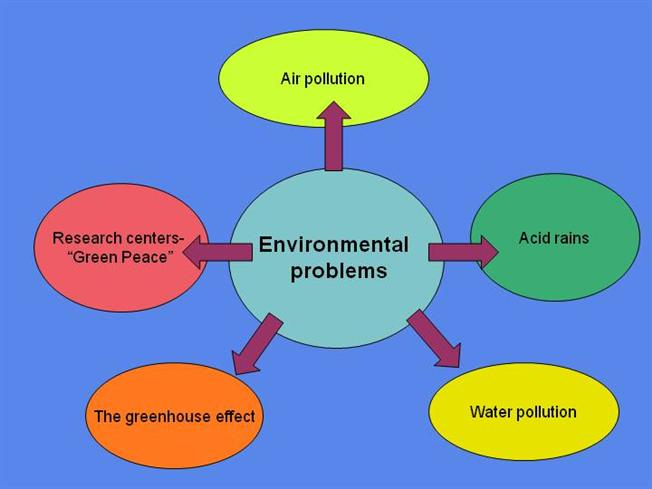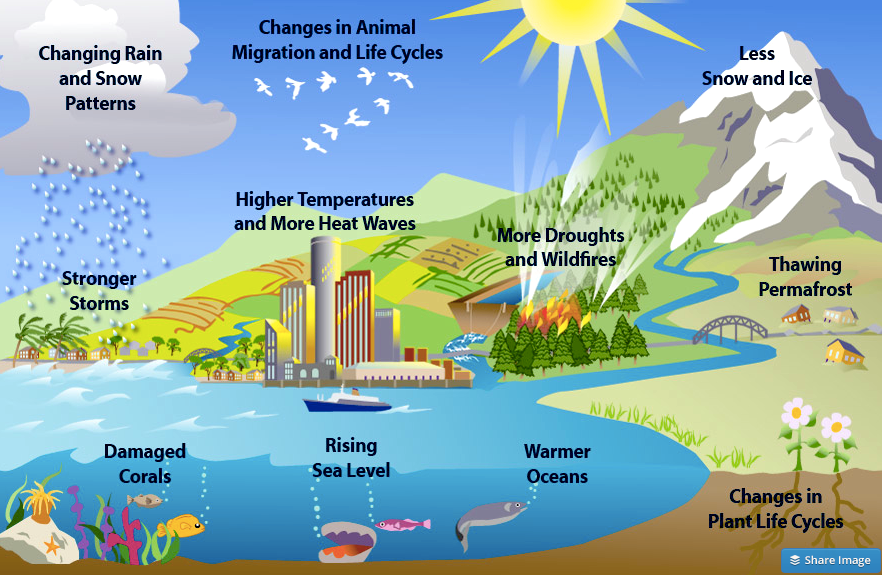Environmental Issues
Table of Content |
Definition of Environment Issues
“Environmental issues refer to the harmful effects of human activity on the biophysical environment.”
In other words, environmental issues include those challenges and problems that have occurred in biophysical environment due to human activity.
Example of Environmental Issues
Some of the examples of environmental issues are Overpopulation, Depletion of Natural Resources, Deforestation, Global Warming, etc.
Environmental Problems or Issues
Our environment is continuously changing and it is resulting in influx of natural disasters, floods, warming, cooling periods, sudden change in weather pattern, and much more. Some of the environmental issues that need due attention are as follows –
-
Pollution – It includes pollution of air, water and soil due to the poisonous and harmful gases produced from factories, industries, combustion of fossil fuel and vehicles. Use of heavy metals, plastics and nitrates also add several types of pollutants in the atmosphere. Water pollution is caused due to acid rain, oil spill and urban runoff and soil pollution is caused majorly from industrial waste as it deprives the soil from essential nutrients.
Following image shows the air pollution caused due to factories and industries, whereby harmful gases are emitted in the atmosphere -
-
Global Warming – Global warming is the result of human practices which includes emission of greenhouse gases. It leads to rapid increase in temperature due to which the polar ice is melting down and this, on the other hand, is resulting in rise in sea level and increase in unnatural pattern of precipitation such as excessive snow, flash floods and desertification.
-
Overpopulation – The population of our planet is reaching to unsustainable level and this is resulting in shortage of fuel, food and water. Population explosion is resulting in scarcity of resources. Intensive agricultural practices are being adopted in order to satisfy the increasing requirement of population and it includes higher usage of chemical fertilizers, pesticides and insecticides.
-
Natural Resource Depletion – It is one of the most crucial environmental issues. The consumption of fossil fuel is resulting in emission of greenhouse gases and this, on the other hand, is resulting in climate change and global warming. People are focusing more and more on the usage of renewable sources of energy like solar energy.
-
Waste Disposal – Due to over consumption of resources and creation of plastics, waste disposal has become another challenge. Developed countries are disposing their waste in oceans and this is affecting the marine life of the aquatic animals. Added to this, nuclear waste disposal is another challenge as it has tremendous health hazard associated with it. Fast food, electronics, packaging, plastics are some of the waste that is threatening the entire ecosystem.
-
Climate Change – Climate change is taking place and has surfaced in last couple of decades. It has occurred due to rise in global warming and burning of fossil fuels. It has resulted in frequent occurrence of floods, occurrence of new diseases, extreme temperatures and change in the overall weather scenario.
-
Loss of Biodiversity – Human activity is also leading to the extinction of various habitats and species and thereby in loss of biodiversity. Ecosystem is in danger as several natural processes are disseminating. For example, the destruction of coral reefs has taken place in various oceans. These reefs supports rich marine life is now endangered.
-
Deforestation – Deforestation is another challenge to environment. These forests are the natural sink of fresh oxygen and helps in regulating rainfall, floods and temperature. But the forest cover is continuously reducing due to increased requirement of land for living, agriculture and industries. Deforestation simply means clearing off the green cover and makes the land available for the use of human activities.
-
Ocean Acidification – Ocean Acidification is the direct impact of release of more carbon dioxide in the environment. The acidity of ocean has significantly increased in last 250 years and it may shoot up to 150% till the year 2100. This is negatively affecting the aquatic life.
-
Ozone Layer Depletion – Ozone layer is the invisible layer that protects the earth from harmful ultra violet radiations of sun. This layer is being depleted due to the rapid increase in pollution caused due to Bromide and Chlorine found on Chlorofluorocarbons (CFC’s). Once these gases reach ozone layer, results in a big damage. As a result of this, the CFC’s are banned in many consumer products and industries.
-
Acid Rain – It occurs due to the presence of pollutants in the atmosphere which is caused due to combustion of fossil fuels, rotting vegetation, erupting volcanoes, etc. These incidences add up sulphur dioxide and nitrogen oxides in the atmosphere which, on the other hand, is leading to acid rain. It is the serious environmental problem that is impacting the health of human, wildlife and aquatic species.
-
Water Pollution – Clean drinking water has become the rare commodity because the development of industries is negatively affecting seas, rivers and oceans by adding pollutants to these water bodies.
-
Urban Sprawl – “It refers to the migration of population from high density urban area to low density rural area.” Urban sprawl is resulting in the spread of cities, land degradation, increased traffic and several health issues. The rapid increase in demand of land is affecting the flora and fauna of the environment.
-
Public Health Issues – Rapid change in environmental conditions is posing the increased risk to health of human and animals. Dirty water is the major cause which is spreading lot of epidemic across the globe. Run-off River carries along several toxic substances and chemicals that are also resulting in heath issue. These pollutants causes respiratory disease such as Asthma and other cardio – vascular problems and increased temperature is resulting in the spread of infectious disease like dengue and malaria.
-
Genetic Engineering – “Genetic modification of food using biotechnology is called genetic engineering.” It results in increased toxins and diseases as genes from allergic plant can transfer to target plant. Genetically modified crops are the serious environmental problem as engineered gene may by toxic for wildlife.
Thus, there are several environmental issues and it is important to take appropriate steps so conserve environment failing which may result in serious outcomes.
Conservation Challenges Around the World
It is important to act right now in order to conserve environment. The Nature Conservancy is taking tough on issues facing conservation. It includes –
-
Protecting Water – It includes protection of several water bodies like rivers, lakes, watersheds, oceans, etc. from getting polluted. In this, the Nature Conservancy is trying to transform the way river systems are developed and managed. It also includes creation of awareness about water pollution and its negative impact.
-
Action on Climate Change – In order to minimize climate change, it is important to work and control the harmful emissions from several sources. The actions are taken to preserve forests and help the nature in adapting to global warming.
-
Saving Oceans – Oceans are the most important source of oxygen and provide half of the oxygen we breathe, along with food and livelihood for millions of organism around the globe. So, it is important to save oceans.
-
Conserving Land – It is mandatory to conserve land at the unprecedented scale as it will benefit the entire ecosystem.
-
Transforming Cities – Around the world, more and more people are moving towards cities and this has increased the cases of floods, droughts and storms. It is important to transform cities such that people are able to living healthy life along with the healthy environment.
Environmental Issues in India
India is facing serious environmental issue because of the recent boom of industries and little or no education or awareness of preventing environment. Main issues in India include:
-
Water – Rivers are on the front line of population due to which the citizens of the country are facing less accessibility to vital and fresh water resources. Industries located here are contaminating water bodies and are responsible of discharging toxins in water.
-
Deforestation – It is another issue and it is predicted that around 5.3 million hectare of forest has been destroyed since independence. Government has now recognized the importance of forest and is taking suitable steps to conserve, but poor management and abuse of power are the big hurdles in conservation.
-
Air Pollution – India is regarded as having the worst air quality across the globe. in big cities like Delhi and Mumbai, millions of dirty and old diesel engines churn tons of sulphur, which on the other hand is resulting in increased rate of asthma problem in children.
-
Plastics and other waste – Waste disposal is another problem in India, whereby people are not aware of proper waste disposal methods. This is resulting in air, water and soil pollution.
Added to these, India is facing other environmental issues like over population, poverty, more dependence on ground water, etc. which is having negative impact on the entire ecosystem. On a brighter note, the use of solar power in India is at boom as compared to other parts of the world.
Following image shows the major environmental issues in India along with figures. For instance, twenty percent of the global carbon dioxide emission is because by deforestation, flooding and soil erosion results from deforestation, etc.
Definition of Global Warming
Global Warming is the increase of Earth's average surface temperature due to effect of greenhouse gases, such as carbon dioxide emissions from burning fossil fuels or from deforestation, which trap heat that would otherwise escape from Earth. This is a type of Greenhouse Effect.
Scientists have documented the rise in temperature since 1800s and have found that the average rise in temperature is 1.4 degree Fahrenheit over the past century and it is projected to increase 2-11.5 degree Fahrenheit over another 100 years.
The Greenhouse Effect
Global warming begins with greenhouse effect caused due to the interaction between incoming radiation from sun and atmosphere of the earth. Solar radiation passes through the atmosphere of Earth, where it is absorbed and then reflected upward in the form of heat. Gases in the atmosphere of earth absorb 90% of this heat and radiate it back.
Following figures explains the greenhouse effect, according to which some of the infrared radiations pass through the atmosphere but most is absorbed and re-emitted in all direction by greenhouse gas molecules and clouds. The effect of this is to warm the surface of the earth and the lower atmosphere.
Greenhouse Gases
The Greenhouse effect is due to greenhouse gases such as water vapor, methane (CH4), carbon dioxide (CO2), and nitrous oxide (N2O). The most important greenhouse gas is Carbon Dioxide (CO2).
Effects of Global Warming
Some of the effects of global warming are rising sea level, melting of polar ice, changes in the pattern of rainfall, increased likelihood of extreme events like hurricanes, floods, melting of glaciers, resulting in loss of habitat, spread of diseases like dengue and malaria, loss of planktons, bleaching of coral reefs due to acidification and warming of oceans.
Following figure shows the effect of global warming on the entire ecosystem. It includes changes in rain and snow patterns, higher temperature, stronger storms, rising of sea level, warmer oceans, damaged corals, etc.
Watch this Video for more reference



